Analysing Organisational Behaviour: Culture, Motivation & Teamwork
VerifiedAdded on 2023/06/12
|29
|6045
|400
Report
AI Summary
This report provides a comprehensive analysis of organisational behaviour within the context of Procter & Gamble. It examines the impact of organisational culture, politics, and power on individual and team behaviour and performance. The report explores content and process theories of motivation, including Maslow's hierarchy of needs, and discusses the characteristics of effective and ineffective teams. Furthermore, it delves into the philosophies of organisational behaviour and their application in various business situations. The analysis highlights the importance of a positive organisational culture, transparent communication, and effective leadership in fostering employee motivation, teamwork, and overall organisational success. This document is available on Desklib, a platform offering a wide array of study tools and resources for students.
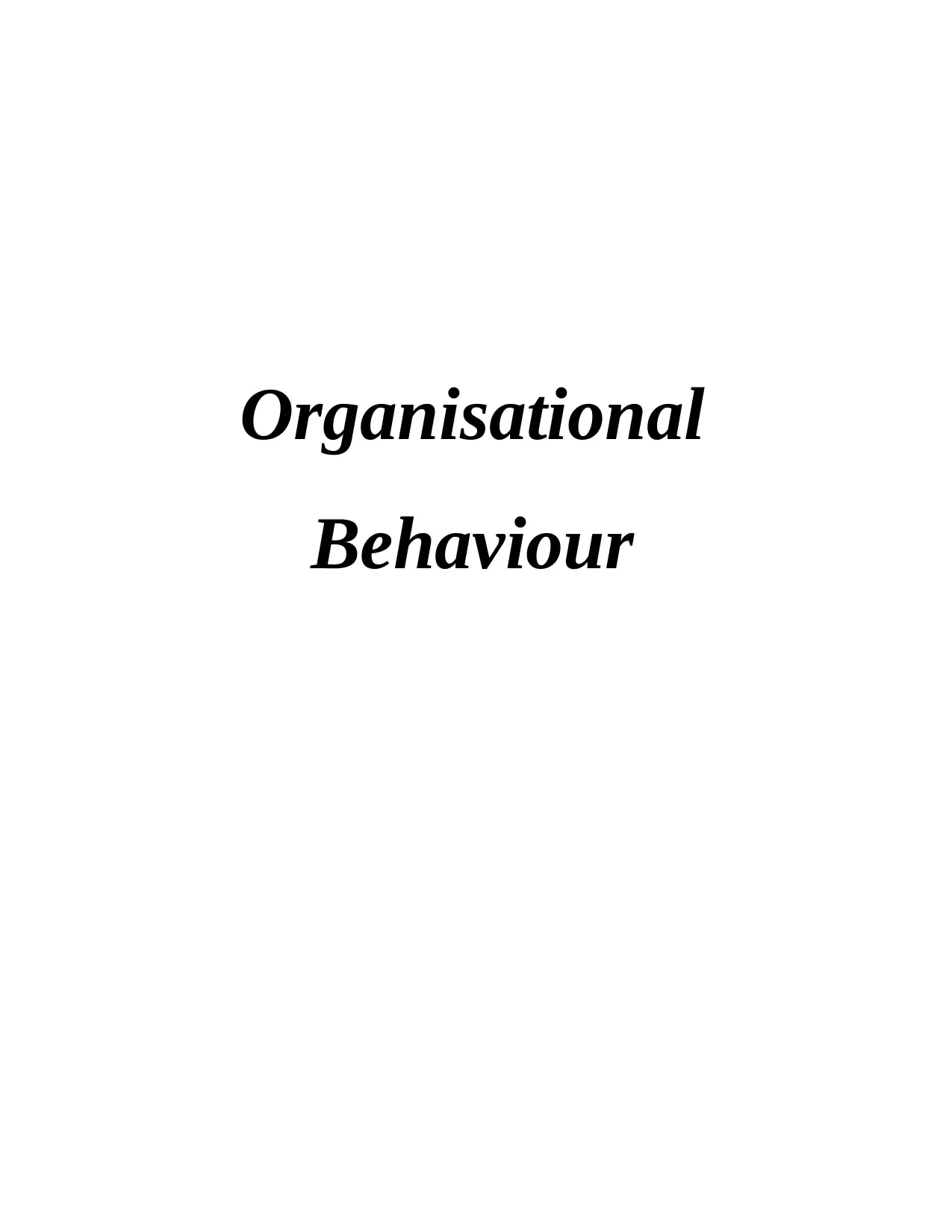
Organisational
Behaviour
Behaviour
Paraphrase This Document
Need a fresh take? Get an instant paraphrase of this document with our AI Paraphraser
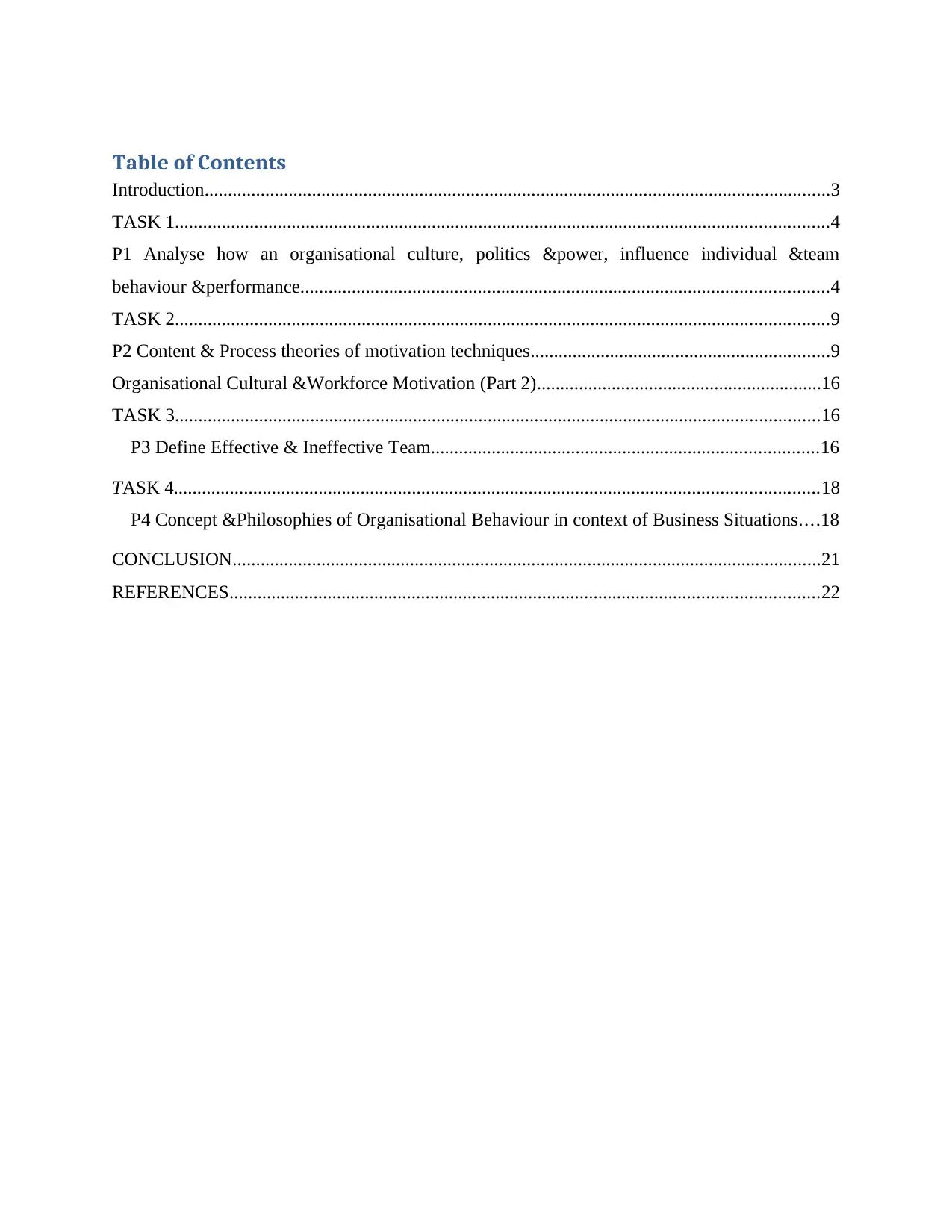
Table of Contents
Introduction......................................................................................................................................3
TASK 1............................................................................................................................................4
P1 Analyse how an organisational culture, politics &power, influence individual &team
behaviour &performance.................................................................................................................4
TASK 2............................................................................................................................................9
P2 Content & Process theories of motivation techniques................................................................9
Organisational Cultural &Workforce Motivation (Part 2).............................................................16
TASK 3..........................................................................................................................................16
P3 Define Effective & Ineffective Team...................................................................................16
TASK 4..........................................................................................................................................18
P4 Concept &Philosophies of Organisational Behaviour in context of Business Situations....18
CONCLUSION..............................................................................................................................21
REFERENCES..............................................................................................................................22
Introduction......................................................................................................................................3
TASK 1............................................................................................................................................4
P1 Analyse how an organisational culture, politics &power, influence individual &team
behaviour &performance.................................................................................................................4
TASK 2............................................................................................................................................9
P2 Content & Process theories of motivation techniques................................................................9
Organisational Cultural &Workforce Motivation (Part 2).............................................................16
TASK 3..........................................................................................................................................16
P3 Define Effective & Ineffective Team...................................................................................16
TASK 4..........................................................................................................................................18
P4 Concept &Philosophies of Organisational Behaviour in context of Business Situations....18
CONCLUSION..............................................................................................................................21
REFERENCES..............................................................................................................................22
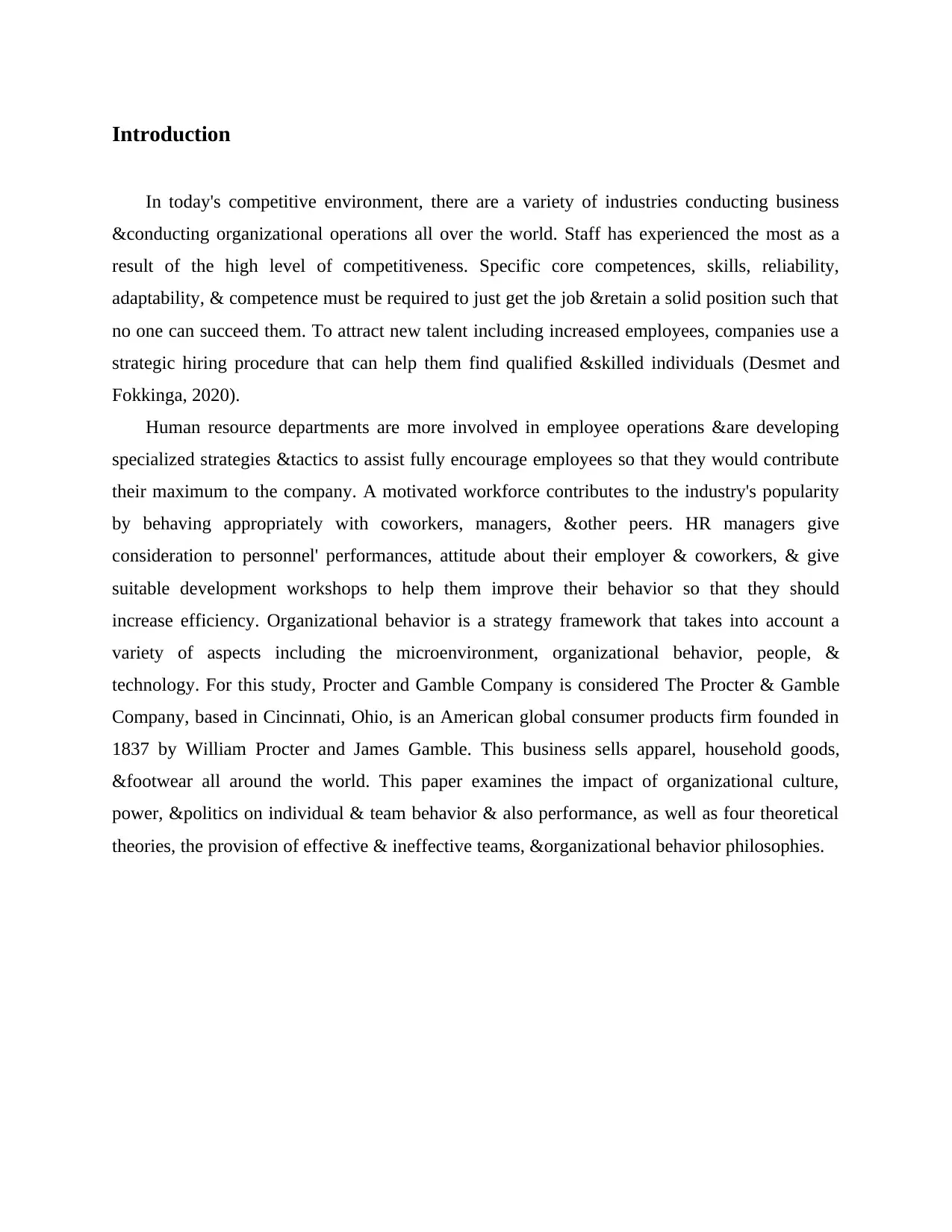
Introduction
In today's competitive environment, there are a variety of industries conducting business
&conducting organizational operations all over the world. Staff has experienced the most as a
result of the high level of competitiveness. Specific core competences, skills, reliability,
adaptability, & competence must be required to just get the job &retain a solid position such that
no one can succeed them. To attract new talent including increased employees, companies use a
strategic hiring procedure that can help them find qualified &skilled individuals (Desmet and
Fokkinga, 2020).
Human resource departments are more involved in employee operations &are developing
specialized strategies &tactics to assist fully encourage employees so that they would contribute
their maximum to the company. A motivated workforce contributes to the industry's popularity
by behaving appropriately with coworkers, managers, &other peers. HR managers give
consideration to personnel' performances, attitude about their employer & coworkers, & give
suitable development workshops to help them improve their behavior so that they should
increase efficiency. Organizational behavior is a strategy framework that takes into account a
variety of aspects including the microenvironment, organizational behavior, people, &
technology. For this study, Procter and Gamble Company is considered The Procter & Gamble
Company, based in Cincinnati, Ohio, is an American global consumer products firm founded in
1837 by William Procter and James Gamble. This business sells apparel, household goods,
&footwear all around the world. This paper examines the impact of organizational culture,
power, &politics on individual & team behavior & also performance, as well as four theoretical
theories, the provision of effective & ineffective teams, &organizational behavior philosophies.
In today's competitive environment, there are a variety of industries conducting business
&conducting organizational operations all over the world. Staff has experienced the most as a
result of the high level of competitiveness. Specific core competences, skills, reliability,
adaptability, & competence must be required to just get the job &retain a solid position such that
no one can succeed them. To attract new talent including increased employees, companies use a
strategic hiring procedure that can help them find qualified &skilled individuals (Desmet and
Fokkinga, 2020).
Human resource departments are more involved in employee operations &are developing
specialized strategies &tactics to assist fully encourage employees so that they would contribute
their maximum to the company. A motivated workforce contributes to the industry's popularity
by behaving appropriately with coworkers, managers, &other peers. HR managers give
consideration to personnel' performances, attitude about their employer & coworkers, & give
suitable development workshops to help them improve their behavior so that they should
increase efficiency. Organizational behavior is a strategy framework that takes into account a
variety of aspects including the microenvironment, organizational behavior, people, &
technology. For this study, Procter and Gamble Company is considered The Procter & Gamble
Company, based in Cincinnati, Ohio, is an American global consumer products firm founded in
1837 by William Procter and James Gamble. This business sells apparel, household goods,
&footwear all around the world. This paper examines the impact of organizational culture,
power, &politics on individual & team behavior & also performance, as well as four theoretical
theories, the provision of effective & ineffective teams, &organizational behavior philosophies.
⊘ This is a preview!⊘
Do you want full access?
Subscribe today to unlock all pages.

Trusted by 1+ million students worldwide
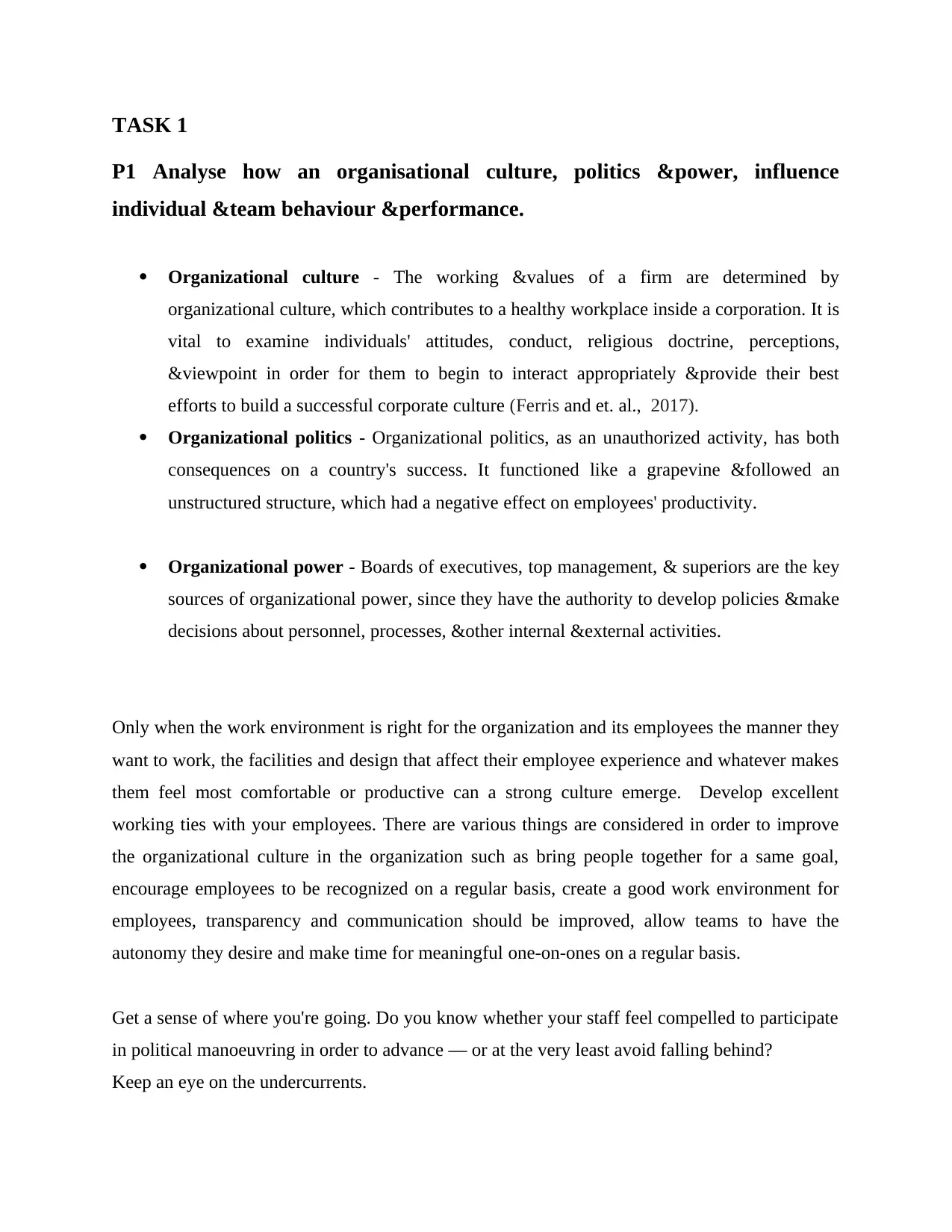
TASK 1
P1 Analyse how an organisational culture, politics &power, influence
individual &team behaviour &performance.
Organizational culture - The working &values of a firm are determined by
organizational culture, which contributes to a healthy workplace inside a corporation. It is
vital to examine individuals' attitudes, conduct, religious doctrine, perceptions,
&viewpoint in order for them to begin to interact appropriately &provide their best
efforts to build a successful corporate culture (Ferris and et. al., 2017).
Organizational politics - Organizational politics, as an unauthorized activity, has both
consequences on a country's success. It functioned like a grapevine &followed an
unstructured structure, which had a negative effect on employees' productivity.
Organizational power - Boards of executives, top management, & superiors are the key
sources of organizational power, since they have the authority to develop policies &make
decisions about personnel, processes, &other internal &external activities.
Only when the work environment is right for the organization and its employees the manner they
want to work, the facilities and design that affect their employee experience and whatever makes
them feel most comfortable or productive can a strong culture emerge. Develop excellent
working ties with your employees. There are various things are considered in order to improve
the organizational culture in the organization such as bring people together for a same goal,
encourage employees to be recognized on a regular basis, create a good work environment for
employees, transparency and communication should be improved, allow teams to have the
autonomy they desire and make time for meaningful one-on-ones on a regular basis.
Get a sense of where you're going. Do you know whether your staff feel compelled to participate
in political manoeuvring in order to advance — or at the very least avoid falling behind?
Keep an eye on the undercurrents.
P1 Analyse how an organisational culture, politics &power, influence
individual &team behaviour &performance.
Organizational culture - The working &values of a firm are determined by
organizational culture, which contributes to a healthy workplace inside a corporation. It is
vital to examine individuals' attitudes, conduct, religious doctrine, perceptions,
&viewpoint in order for them to begin to interact appropriately &provide their best
efforts to build a successful corporate culture (Ferris and et. al., 2017).
Organizational politics - Organizational politics, as an unauthorized activity, has both
consequences on a country's success. It functioned like a grapevine &followed an
unstructured structure, which had a negative effect on employees' productivity.
Organizational power - Boards of executives, top management, & superiors are the key
sources of organizational power, since they have the authority to develop policies &make
decisions about personnel, processes, &other internal &external activities.
Only when the work environment is right for the organization and its employees the manner they
want to work, the facilities and design that affect their employee experience and whatever makes
them feel most comfortable or productive can a strong culture emerge. Develop excellent
working ties with your employees. There are various things are considered in order to improve
the organizational culture in the organization such as bring people together for a same goal,
encourage employees to be recognized on a regular basis, create a good work environment for
employees, transparency and communication should be improved, allow teams to have the
autonomy they desire and make time for meaningful one-on-ones on a regular basis.
Get a sense of where you're going. Do you know whether your staff feel compelled to participate
in political manoeuvring in order to advance — or at the very least avoid falling behind?
Keep an eye on the undercurrents.
Paraphrase This Document
Need a fresh take? Get an instant paraphrase of this document with our AI Paraphraser
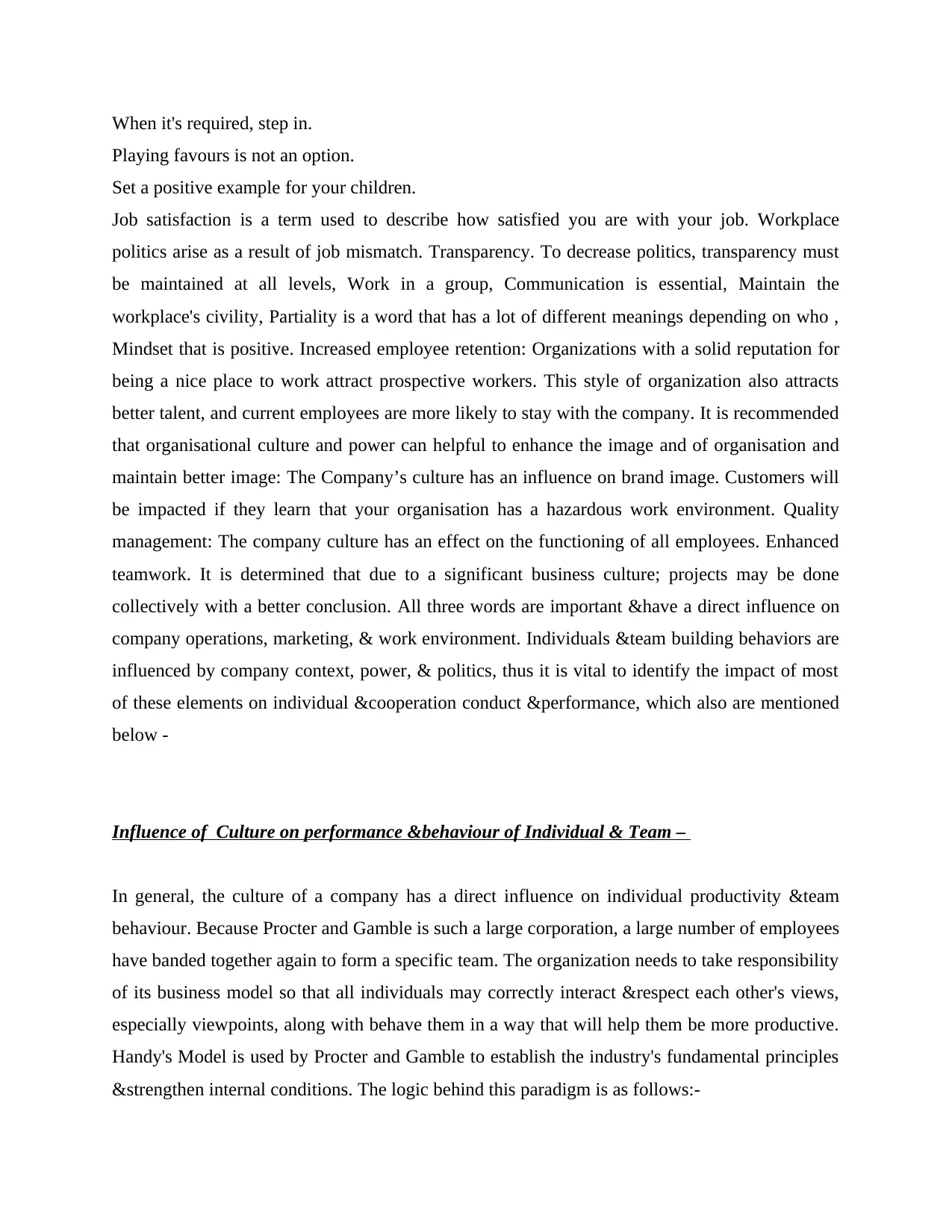
When it's required, step in.
Playing favours is not an option.
Set a positive example for your children.
Job satisfaction is a term used to describe how satisfied you are with your job. Workplace
politics arise as a result of job mismatch. Transparency. To decrease politics, transparency must
be maintained at all levels, Work in a group, Communication is essential, Maintain the
workplace's civility, Partiality is a word that has a lot of different meanings depending on who ,
Mindset that is positive. Increased employee retention: Organizations with a solid reputation for
being a nice place to work attract prospective workers. This style of organization also attracts
better talent, and current employees are more likely to stay with the company. It is recommended
that organisational culture and power can helpful to enhance the image and of organisation and
maintain better image: The Company’s culture has an influence on brand image. Customers will
be impacted if they learn that your organisation has a hazardous work environment. Quality
management: The company culture has an effect on the functioning of all employees. Enhanced
teamwork. It is determined that due to a significant business culture; projects may be done
collectively with a better conclusion. All three words are important &have a direct influence on
company operations, marketing, & work environment. Individuals &team building behaviors are
influenced by company context, power, & politics, thus it is vital to identify the impact of most
of these elements on individual &cooperation conduct &performance, which also are mentioned
below -
Influence of Culture on performance &behaviour of Individual & Team –
In general, the culture of a company has a direct influence on individual productivity &team
behaviour. Because Procter and Gamble is such a large corporation, a large number of employees
have banded together again to form a specific team. The organization needs to take responsibility
of its business model so that all individuals may correctly interact &respect each other's views,
especially viewpoints, along with behave them in a way that will help them be more productive.
Handy's Model is used by Procter and Gamble to establish the industry's fundamental principles
&strengthen internal conditions. The logic behind this paradigm is as follows:-
Playing favours is not an option.
Set a positive example for your children.
Job satisfaction is a term used to describe how satisfied you are with your job. Workplace
politics arise as a result of job mismatch. Transparency. To decrease politics, transparency must
be maintained at all levels, Work in a group, Communication is essential, Maintain the
workplace's civility, Partiality is a word that has a lot of different meanings depending on who ,
Mindset that is positive. Increased employee retention: Organizations with a solid reputation for
being a nice place to work attract prospective workers. This style of organization also attracts
better talent, and current employees are more likely to stay with the company. It is recommended
that organisational culture and power can helpful to enhance the image and of organisation and
maintain better image: The Company’s culture has an influence on brand image. Customers will
be impacted if they learn that your organisation has a hazardous work environment. Quality
management: The company culture has an effect on the functioning of all employees. Enhanced
teamwork. It is determined that due to a significant business culture; projects may be done
collectively with a better conclusion. All three words are important &have a direct influence on
company operations, marketing, & work environment. Individuals &team building behaviors are
influenced by company context, power, & politics, thus it is vital to identify the impact of most
of these elements on individual &cooperation conduct &performance, which also are mentioned
below -
Influence of Culture on performance &behaviour of Individual & Team –
In general, the culture of a company has a direct influence on individual productivity &team
behaviour. Because Procter and Gamble is such a large corporation, a large number of employees
have banded together again to form a specific team. The organization needs to take responsibility
of its business model so that all individuals may correctly interact &respect each other's views,
especially viewpoints, along with behave them in a way that will help them be more productive.
Handy's Model is used by Procter and Gamble to establish the industry's fundamental principles
&strengthen internal conditions. The logic behind this paradigm is as follows:-
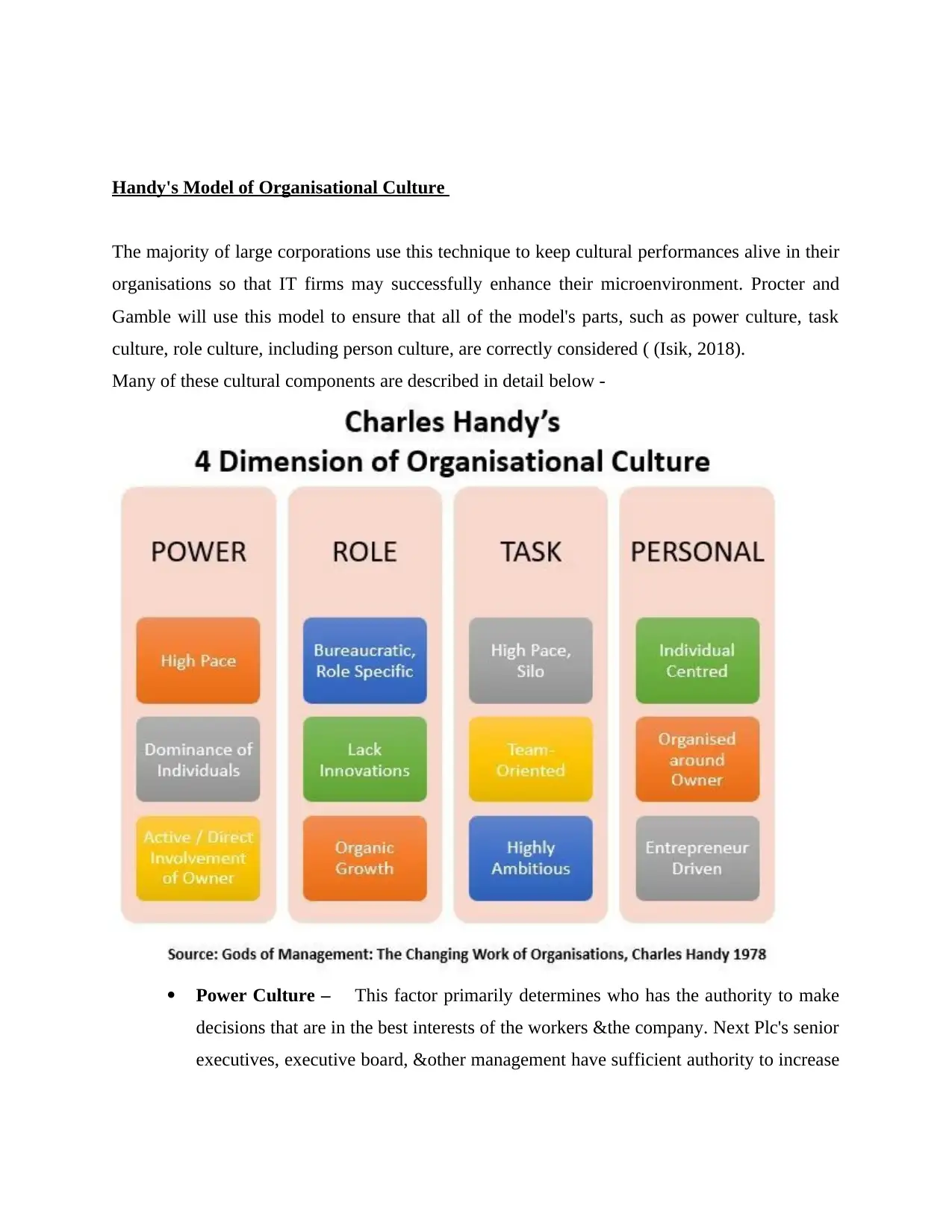
Handy's Model of Organisational Culture
The majority of large corporations use this technique to keep cultural performances alive in their
organisations so that IT firms may successfully enhance their microenvironment. Procter and
Gamble will use this model to ensure that all of the model's parts, such as power culture, task
culture, role culture, including person culture, are correctly considered ( (Isik, 2018).
Many of these cultural components are described in detail below -
Power Culture – This factor primarily determines who has the authority to make
decisions that are in the best interests of the workers &the company. Next Plc's senior
executives, executive board, &other management have sufficient authority to increase
The majority of large corporations use this technique to keep cultural performances alive in their
organisations so that IT firms may successfully enhance their microenvironment. Procter and
Gamble will use this model to ensure that all of the model's parts, such as power culture, task
culture, role culture, including person culture, are correctly considered ( (Isik, 2018).
Many of these cultural components are described in detail below -
Power Culture – This factor primarily determines who has the authority to make
decisions that are in the best interests of the workers &the company. Next Plc's senior
executives, executive board, &other management have sufficient authority to increase
⊘ This is a preview!⊘
Do you want full access?
Subscribe today to unlock all pages.

Trusted by 1+ million students worldwide
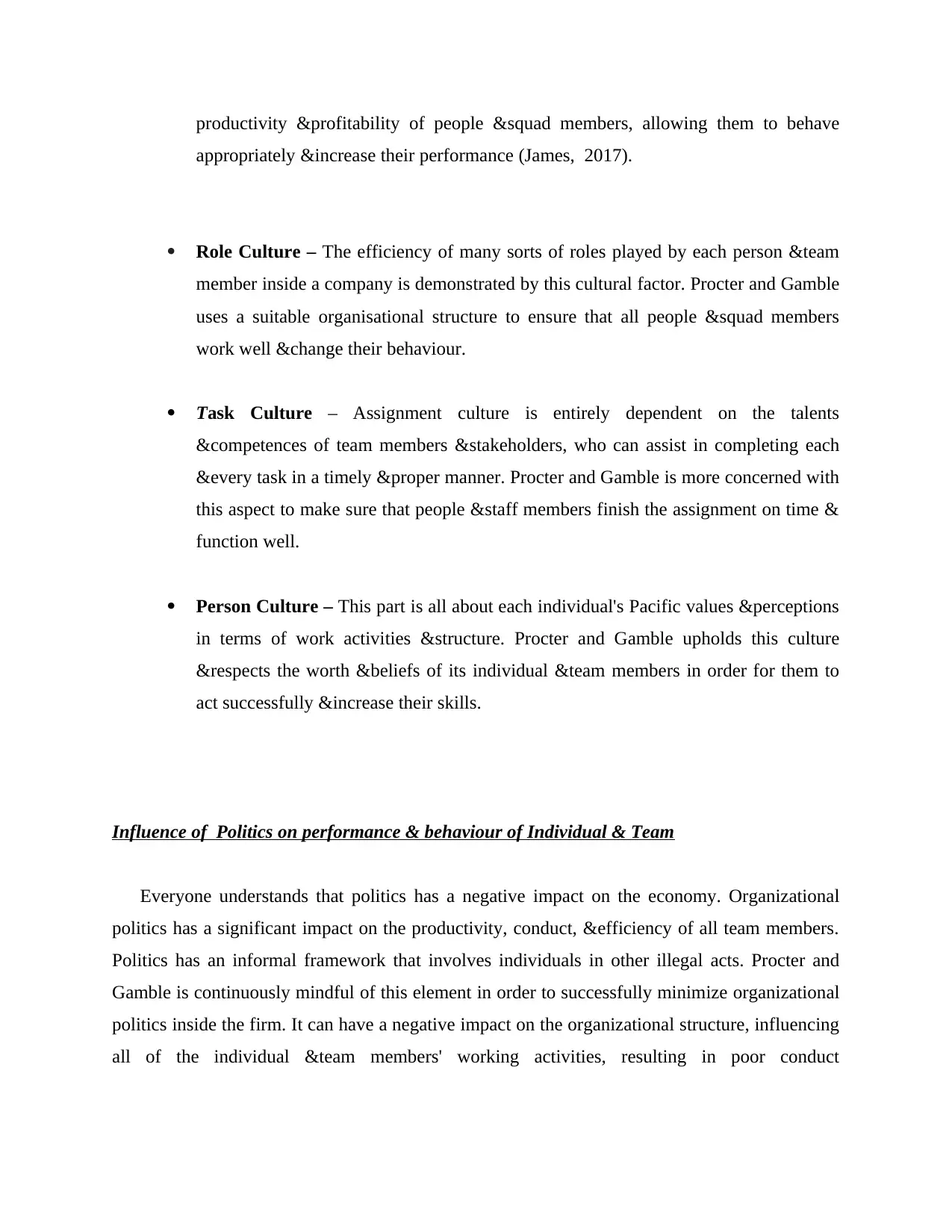
productivity &profitability of people &squad members, allowing them to behave
appropriately &increase their performance (James, 2017).
Role Culture – The efficiency of many sorts of roles played by each person &team
member inside a company is demonstrated by this cultural factor. Procter and Gamble
uses a suitable organisational structure to ensure that all people &squad members
work well &change their behaviour.
Task Culture – Assignment culture is entirely dependent on the talents
&competences of team members &stakeholders, who can assist in completing each
&every task in a timely &proper manner. Procter and Gamble is more concerned with
this aspect to make sure that people &staff members finish the assignment on time &
function well.
Person Culture – This part is all about each individual's Pacific values &perceptions
in terms of work activities &structure. Procter and Gamble upholds this culture
&respects the worth &beliefs of its individual &team members in order for them to
act successfully &increase their skills.
Influence of Politics on performance & behaviour of Individual & Team
Everyone understands that politics has a negative impact on the economy. Organizational
politics has a significant impact on the productivity, conduct, &efficiency of all team members.
Politics has an informal framework that involves individuals in other illegal acts. Procter and
Gamble is continuously mindful of this element in order to successfully minimize organizational
politics inside the firm. It can have a negative impact on the organizational structure, influencing
all of the individual &team members' working activities, resulting in poor conduct
appropriately &increase their performance (James, 2017).
Role Culture – The efficiency of many sorts of roles played by each person &team
member inside a company is demonstrated by this cultural factor. Procter and Gamble
uses a suitable organisational structure to ensure that all people &squad members
work well &change their behaviour.
Task Culture – Assignment culture is entirely dependent on the talents
&competences of team members &stakeholders, who can assist in completing each
&every task in a timely &proper manner. Procter and Gamble is more concerned with
this aspect to make sure that people &staff members finish the assignment on time &
function well.
Person Culture – This part is all about each individual's Pacific values &perceptions
in terms of work activities &structure. Procter and Gamble upholds this culture
&respects the worth &beliefs of its individual &team members in order for them to
act successfully &increase their skills.
Influence of Politics on performance & behaviour of Individual & Team
Everyone understands that politics has a negative impact on the economy. Organizational
politics has a significant impact on the productivity, conduct, &efficiency of all team members.
Politics has an informal framework that involves individuals in other illegal acts. Procter and
Gamble is continuously mindful of this element in order to successfully minimize organizational
politics inside the firm. It can have a negative impact on the organizational structure, influencing
all of the individual &team members' working activities, resulting in poor conduct
Paraphrase This Document
Need a fresh take? Get an instant paraphrase of this document with our AI Paraphraser
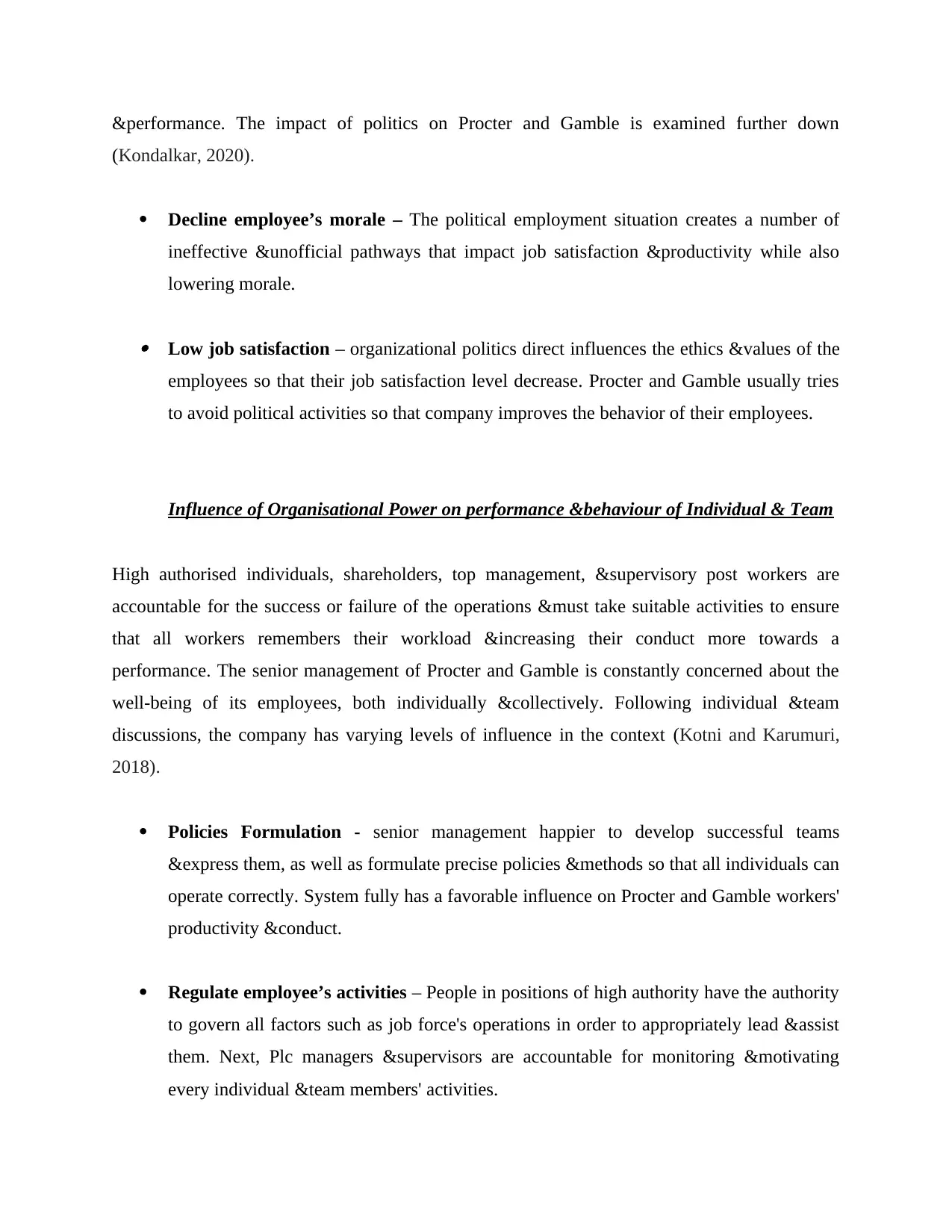
&performance. The impact of politics on Procter and Gamble is examined further down
(Kondalkar, 2020).
Decline employee’s morale – The political employment situation creates a number of
ineffective &unofficial pathways that impact job satisfaction &productivity while also
lowering morale.
Low job satisfaction – organizational politics direct influences the ethics &values of the
employees so that their job satisfaction level decrease. Procter and Gamble usually tries
to avoid political activities so that company improves the behavior of their employees.
Influence of Organisational Power on performance &behaviour of Individual & Team
High authorised individuals, shareholders, top management, &supervisory post workers are
accountable for the success or failure of the operations &must take suitable activities to ensure
that all workers remembers their workload &increasing their conduct more towards a
performance. The senior management of Procter and Gamble is constantly concerned about the
well-being of its employees, both individually &collectively. Following individual &team
discussions, the company has varying levels of influence in the context (Kotni and Karumuri,
2018).
Policies Formulation - senior management happier to develop successful teams
&express them, as well as formulate precise policies &methods so that all individuals can
operate correctly. System fully has a favorable influence on Procter and Gamble workers'
productivity &conduct.
Regulate employee’s activities – People in positions of high authority have the authority
to govern all factors such as job force's operations in order to appropriately lead &assist
them. Next, Plc managers &supervisors are accountable for monitoring &motivating
every individual &team members' activities.
(Kondalkar, 2020).
Decline employee’s morale – The political employment situation creates a number of
ineffective &unofficial pathways that impact job satisfaction &productivity while also
lowering morale.
Low job satisfaction – organizational politics direct influences the ethics &values of the
employees so that their job satisfaction level decrease. Procter and Gamble usually tries
to avoid political activities so that company improves the behavior of their employees.
Influence of Organisational Power on performance &behaviour of Individual & Team
High authorised individuals, shareholders, top management, &supervisory post workers are
accountable for the success or failure of the operations &must take suitable activities to ensure
that all workers remembers their workload &increasing their conduct more towards a
performance. The senior management of Procter and Gamble is constantly concerned about the
well-being of its employees, both individually &collectively. Following individual &team
discussions, the company has varying levels of influence in the context (Kotni and Karumuri,
2018).
Policies Formulation - senior management happier to develop successful teams
&express them, as well as formulate precise policies &methods so that all individuals can
operate correctly. System fully has a favorable influence on Procter and Gamble workers'
productivity &conduct.
Regulate employee’s activities – People in positions of high authority have the authority
to govern all factors such as job force's operations in order to appropriately lead &assist
them. Next, Plc managers &supervisors are accountable for monitoring &motivating
every individual &team members' activities.
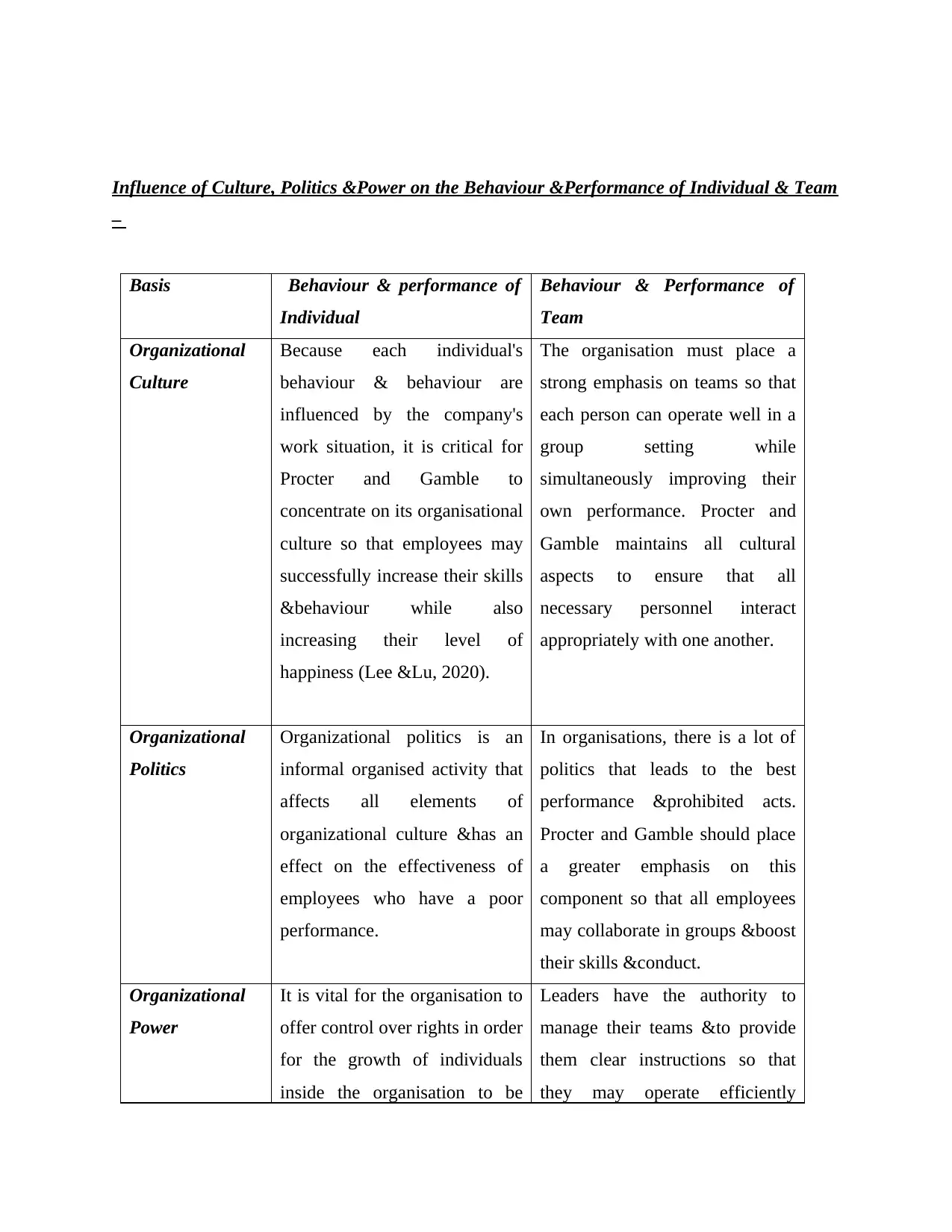
Influence of Culture, Politics &Power on the Behaviour &Performance of Individual & Team
–
Basis Behaviour & performance of
Individual
Behaviour & Performance of
Team
Organizational
Culture
Because each individual's
behaviour & behaviour are
influenced by the company's
work situation, it is critical for
Procter and Gamble to
concentrate on its organisational
culture so that employees may
successfully increase their skills
&behaviour while also
increasing their level of
happiness (Lee &Lu, 2020).
The organisation must place a
strong emphasis on teams so that
each person can operate well in a
group setting while
simultaneously improving their
own performance. Procter and
Gamble maintains all cultural
aspects to ensure that all
necessary personnel interact
appropriately with one another.
Organizational
Politics
Organizational politics is an
informal organised activity that
affects all elements of
organizational culture &has an
effect on the effectiveness of
employees who have a poor
performance.
In organisations, there is a lot of
politics that leads to the best
performance &prohibited acts.
Procter and Gamble should place
a greater emphasis on this
component so that all employees
may collaborate in groups &boost
their skills &conduct.
Organizational
Power
It is vital for the organisation to
offer control over rights in order
for the growth of individuals
inside the organisation to be
Leaders have the authority to
manage their teams &to provide
them clear instructions so that
they may operate efficiently
–
Basis Behaviour & performance of
Individual
Behaviour & Performance of
Team
Organizational
Culture
Because each individual's
behaviour & behaviour are
influenced by the company's
work situation, it is critical for
Procter and Gamble to
concentrate on its organisational
culture so that employees may
successfully increase their skills
&behaviour while also
increasing their level of
happiness (Lee &Lu, 2020).
The organisation must place a
strong emphasis on teams so that
each person can operate well in a
group setting while
simultaneously improving their
own performance. Procter and
Gamble maintains all cultural
aspects to ensure that all
necessary personnel interact
appropriately with one another.
Organizational
Politics
Organizational politics is an
informal organised activity that
affects all elements of
organizational culture &has an
effect on the effectiveness of
employees who have a poor
performance.
In organisations, there is a lot of
politics that leads to the best
performance &prohibited acts.
Procter and Gamble should place
a greater emphasis on this
component so that all employees
may collaborate in groups &boost
their skills &conduct.
Organizational
Power
It is vital for the organisation to
offer control over rights in order
for the growth of individuals
inside the organisation to be
Leaders have the authority to
manage their teams &to provide
them clear instructions so that
they may operate efficiently
⊘ This is a preview!⊘
Do you want full access?
Subscribe today to unlock all pages.

Trusted by 1+ million students worldwide
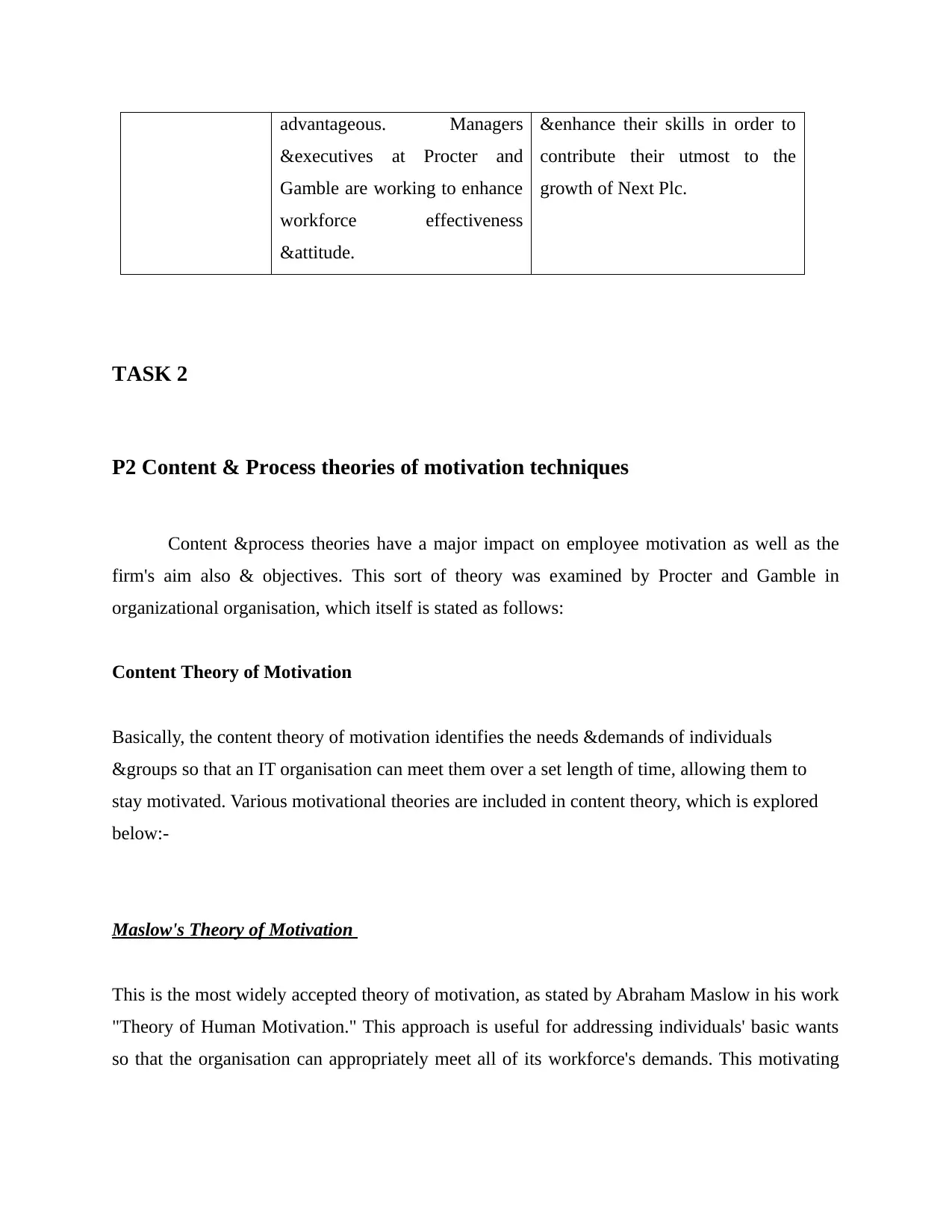
advantageous. Managers
&executives at Procter and
Gamble are working to enhance
workforce effectiveness
&attitude.
&enhance their skills in order to
contribute their utmost to the
growth of Next Plc.
TASK 2
P2 Content & Process theories of motivation techniques
Content &process theories have a major impact on employee motivation as well as the
firm's aim also & objectives. This sort of theory was examined by Procter and Gamble in
organizational organisation, which itself is stated as follows:
Content Theory of Motivation
Basically, the content theory of motivation identifies the needs &demands of individuals
&groups so that an IT organisation can meet them over a set length of time, allowing them to
stay motivated. Various motivational theories are included in content theory, which is explored
below:-
Maslow's Theory of Motivation
This is the most widely accepted theory of motivation, as stated by Abraham Maslow in his work
"Theory of Human Motivation." This approach is useful for addressing individuals' basic wants
so that the organisation can appropriately meet all of its workforce's demands. This motivating
&executives at Procter and
Gamble are working to enhance
workforce effectiveness
&attitude.
&enhance their skills in order to
contribute their utmost to the
growth of Next Plc.
TASK 2
P2 Content & Process theories of motivation techniques
Content &process theories have a major impact on employee motivation as well as the
firm's aim also & objectives. This sort of theory was examined by Procter and Gamble in
organizational organisation, which itself is stated as follows:
Content Theory of Motivation
Basically, the content theory of motivation identifies the needs &demands of individuals
&groups so that an IT organisation can meet them over a set length of time, allowing them to
stay motivated. Various motivational theories are included in content theory, which is explored
below:-
Maslow's Theory of Motivation
This is the most widely accepted theory of motivation, as stated by Abraham Maslow in his work
"Theory of Human Motivation." This approach is useful for addressing individuals' basic wants
so that the organisation can appropriately meet all of its workforce's demands. This motivating
Paraphrase This Document
Need a fresh take? Get an instant paraphrase of this document with our AI Paraphraser
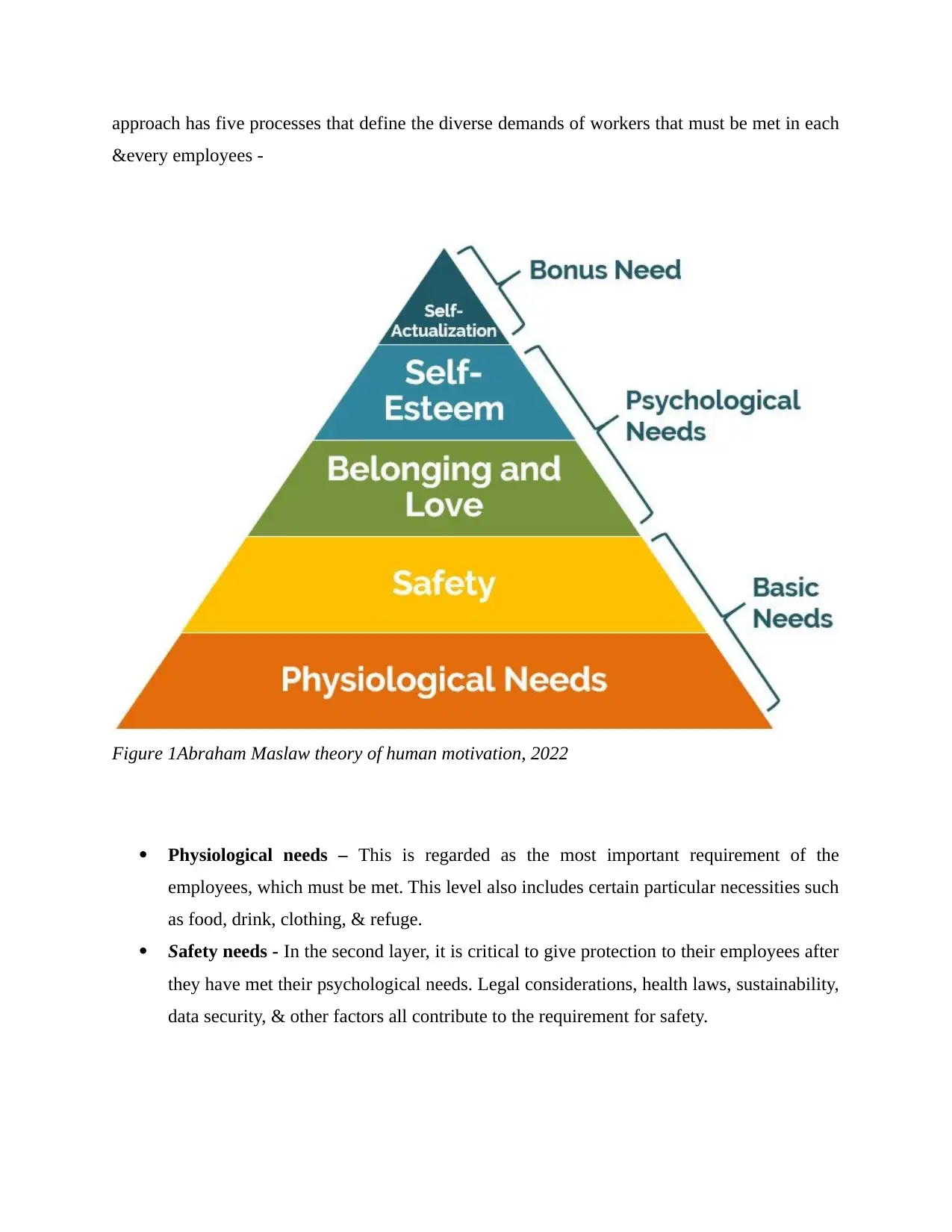
approach has five processes that define the diverse demands of workers that must be met in each
&every employees -
Figure 1Abraham Maslaw theory of human motivation, 2022
Physiological needs – This is regarded as the most important requirement of the
employees, which must be met. This level also includes certain particular necessities such
as food, drink, clothing, & refuge.
Safety needs - In the second layer, it is critical to give protection to their employees after
they have met their psychological needs. Legal considerations, health laws, sustainability,
data security, & other factors all contribute to the requirement for safety.
&every employees -
Figure 1Abraham Maslaw theory of human motivation, 2022
Physiological needs – This is regarded as the most important requirement of the
employees, which must be met. This level also includes certain particular necessities such
as food, drink, clothing, & refuge.
Safety needs - In the second layer, it is critical to give protection to their employees after
they have met their psychological needs. Legal considerations, health laws, sustainability,
data security, & other factors all contribute to the requirement for safety.
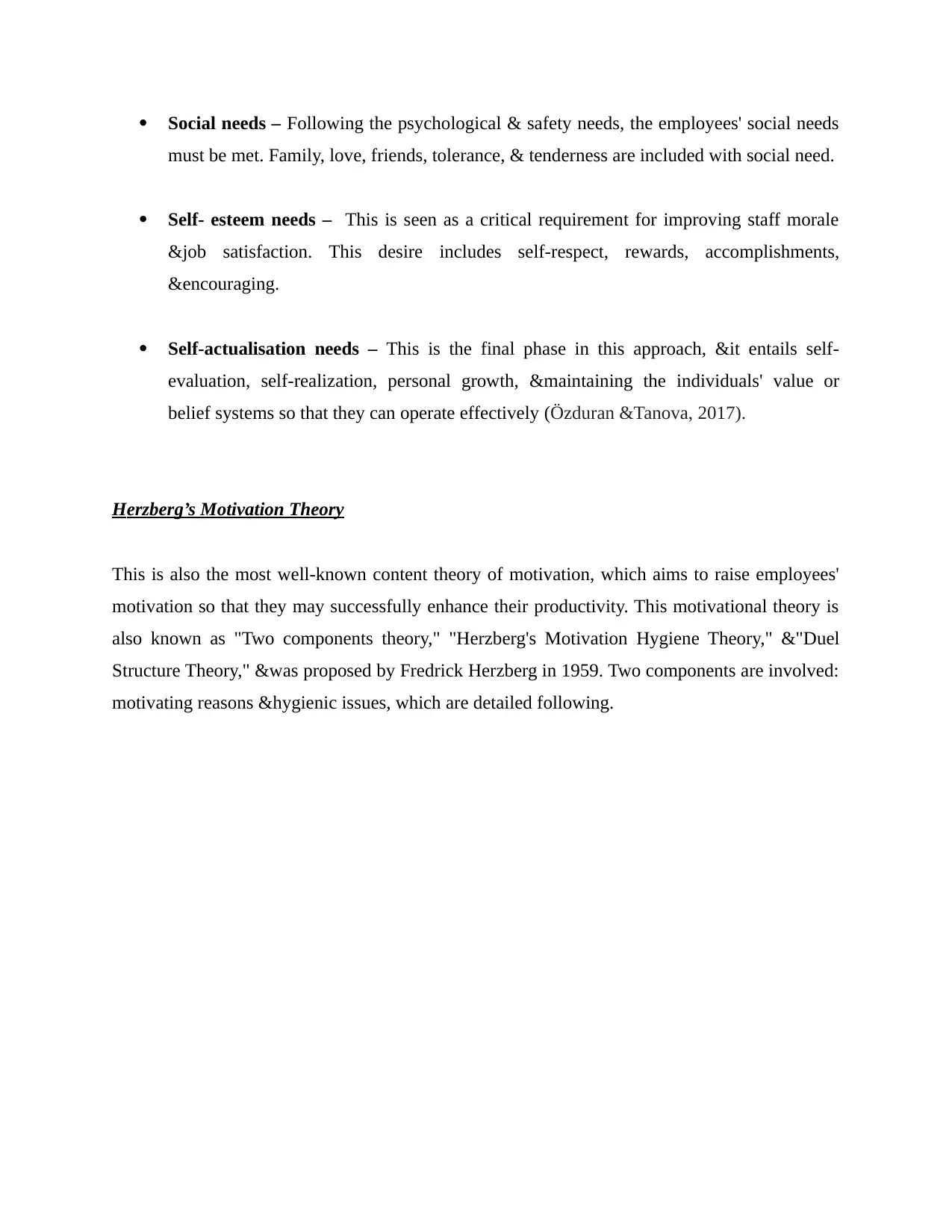
Social needs – Following the psychological & safety needs, the employees' social needs
must be met. Family, love, friends, tolerance, & tenderness are included with social need.
Self- esteem needs – This is seen as a critical requirement for improving staff morale
&job satisfaction. This desire includes self-respect, rewards, accomplishments,
&encouraging.
Self-actualisation needs – This is the final phase in this approach, &it entails self-
evaluation, self-realization, personal growth, &maintaining the individuals' value or
belief systems so that they can operate effectively (Özduran &Tanova, 2017).
Herzberg’s Motivation Theory
This is also the most well-known content theory of motivation, which aims to raise employees'
motivation so that they may successfully enhance their productivity. This motivational theory is
also known as "Two components theory," "Herzberg's Motivation Hygiene Theory," &"Duel
Structure Theory," &was proposed by Fredrick Herzberg in 1959. Two components are involved:
motivating reasons &hygienic issues, which are detailed following.
must be met. Family, love, friends, tolerance, & tenderness are included with social need.
Self- esteem needs – This is seen as a critical requirement for improving staff morale
&job satisfaction. This desire includes self-respect, rewards, accomplishments,
&encouraging.
Self-actualisation needs – This is the final phase in this approach, &it entails self-
evaluation, self-realization, personal growth, &maintaining the individuals' value or
belief systems so that they can operate effectively (Özduran &Tanova, 2017).
Herzberg’s Motivation Theory
This is also the most well-known content theory of motivation, which aims to raise employees'
motivation so that they may successfully enhance their productivity. This motivational theory is
also known as "Two components theory," "Herzberg's Motivation Hygiene Theory," &"Duel
Structure Theory," &was proposed by Fredrick Herzberg in 1959. Two components are involved:
motivating reasons &hygienic issues, which are detailed following.
⊘ This is a preview!⊘
Do you want full access?
Subscribe today to unlock all pages.

Trusted by 1+ million students worldwide
1 out of 29
Related Documents
Your All-in-One AI-Powered Toolkit for Academic Success.
+13062052269
info@desklib.com
Available 24*7 on WhatsApp / Email
![[object Object]](/_next/static/media/star-bottom.7253800d.svg)
Unlock your academic potential
Copyright © 2020–2025 A2Z Services. All Rights Reserved. Developed and managed by ZUCOL.




